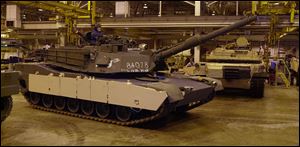
Debt deal muddies future of Lima's tanks
8/4/2011
An M1 A2 tank is driven out of the Test and Acceptance facility by mechanics at the Army tank plant in Lima, Ohio.
LIMA, Ohio -- The deal this week to stave off a national default might carry an especially bitter pill for workers in Lima who are trying to save their jobs at the plant that makes the nation's primary battle tank.
Or not. Nobody really knows yet.
Earlier this summer, both the U.S. House Appropriations Committee and the Senate Armed Services Committee had approved additional funding that would have kept the Joint Systems Manufacturing Center in Lima, Ohio, home of the Abrams tank, operating beyond its planned shutdown in 2013.
The committee votes, to provide between $272 and $325 million, would have paid for 60 to 70 additional Abrams tanks to help bridge the facility for some of the three-year period between 2013 and 2016. That's when the Army says the General Dynamics Land Systems will have fulfilled its Abrams contract and when the service said it would next need an Abrams upgrade.
But the last-minute debt ceiling law approved by Congress and signed by President Obama this week calls for large, unspecified cuts to defense expenditures, leaving those who have been making progress at keeping the plant's 200 hourly workers on the job in limbo.
"I don't think anybody knows," said Pete Keating, a spokesman for General Dynamics Land Systems in suburban Detroit. "The details [of the deficit cuts to defense] are really going to come out in the fall."
The legislation that raised the government's authorized debt ceiling this week also put in automatic spending reduction "triggers" that would cut $600 billion from defense spending over a 10-year period if a new "super committee" of a dozen bipartisan lawmakers from both houses of Congress were unable to come to terms on a broader deficit-reduction package. Just how those cuts -- which are matched with another $600 billion in nondefense spending -- would be implemented has yet to be determined.
The plant had more than 1,200 employees this year but slowly has lost jobs as refurbishment operations on earlier Abrams and international orders dwindle. The plant began producing Abrams battle tanks for the Army and allied militaries in 1981 and during the last three decades has produced nearly 10,000 of the 65-ton behemoths, including 8,000 for the Army. For the last several years, the plant has refurbished earlier versions of the tank, installing new electronics, armament, mechanics, and other modifications, and has put the restored units back into service.
General Dynamics had hoped to use the northwest Ohio plant to produce an armored Expeditionary Fighting Vehicle for the Marine Corps and a manned combat vehicle for the Army, but those programs have been cut by the Pentagon. Within the last several years, the plant has produced copies of the Abrams for nations that include Iraq and Saudi Arabia.
Steve Kemp, assistant director for the Ohio region of the United Auto Workers, which represents the plant's hourly workers, said the organization continues to lobby on behalf of its members to keep the tank plant operating.
"Right now, we're trying to get other manufacturers involved to try to help," Mr. Kemp said.
Contact Larry P. Vellequette at: lvellequette@theblade.com or 419-724-6091.